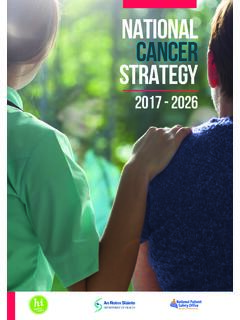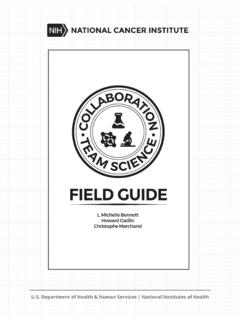Transcription of Sharing the Vision
1 Prepared by the Department of the VisionA Mental Health Policy for Everyone Prepared by the Department of the VisionA Mental Health Policy for Everyone Prepared by the Department of the Vision | A Mental Health Policy for EveryoneList of Abbreviations 6 Chapter 1 | Background and Context 11 Introduction 13 The refresh process 13 Oversight Group 13 Methodology 14 Framework 15 Core Values 16 The Vision 16 Principles 17 Implementation 19 Chapter 2 | Promotion, Prevention and Early Intervention Domain 23 Introduction 24 Positive mental health and wellbeing 25 Mental health lifecycle 26 The Lifecycle Approach 26 Mental Health across the Lifecycle 27 Mental health, priority groups and stigma 29 Additional health promotion supports 30 Health Promotion Programmes 30 Voluntary and Community Sector 30 Digital Mental Health 30 Chapter 3 | Service Access, Coordination and Continuity of Care Domain 33 Introduction 34 Pathways to support 36 Primary Care 40 Integrated services 41 Community Mental Health Teams 44 Clinical leadership 45 Alternative Access Routes to Emergency Care 45 Specialist mental health services across the lifecycle 47 Child and adolescent mental health services 47 The 0 25 cohort 47 General adult mental health services (GAMHS)
2 48 Adult inpatient capacity and alternatives to inpatient admission 48 Mental health services for older people 50 Table of Contents4 Tailored interventions 50 Forensic mental health services 50 Dual diagnosis 53 Mental health services for homeless people 54 Liaison mental health services 54 Specialist needs-based services 54 Intensive recovery support services (for individuals with complex mental health difficulties) 54 Mental health services for early intervention in psychosis 55 People with an intellectual disability 56 ADHD 56 Suicide prevention 56 Eating disorders 57 Specialist perinatal supports 57 Neuro-rehabilitation (including acquired brain injury) 57 Providing mental health services that recognise and respond to diversity 57 Access to advocacy 58 Chapter 4 | Social Inclusion Domain 65 Introduction 66 Equality of access 67 Housing supports 67 Employment supports 68 Training and vocational education supports 68 Income protection and social welfare 68 Peer-led.
3 Peer-run and community development projects 68 5 Sharing the Vision | A Mental Health Policy for EveryoneChapter 5 | Accountability and Continuous Improvement Domain 71 Introduction 72 Accountability and continuous improvement 73 Governance leadership and organisation 73 Patient safety 74 Disadvantage and service planning 74 Physical infrastructure for mental health services 75 Measuring performance 75 Capturing and embedding innovation 75 Meeting standards in quality frameworks and best practice guidelines 76 Enablers 76 Safeguarding vulnerable people 78 Service users, self-harm and suicide 78 Involuntary detention 78 Chapter 6 | Implementation 83 Introduction 84 National Implementation and Monitoring Committee 85 HSE Sharing the Vision structure 85 Implementation roadmap 85 List of Appendices 89 Appendix I: Terms of Reference for the Oversight Group 90 Appendix II: Membership of the Oversight Group 91 Appendix III.
4 Implementation Roadmap 94 References 111 Bibliography 1136 Glossary of AbbreviationsACEs Adverse Childhood Experiences AHPs Allied Health professionals AVFC A Vision for Change CAMHS Child and Adolescent Mental Health Services CFL Connecting for Life CHN Community Health Network CHO Community Healthcare Organisation CIPC Counselling in Primary Care CMH Central Mental Hospital CMHTs Community Mental Health Teams CNS Clinical Nurse Specialist COG CAMHS Operational Guidance CPD Continuing Professional Development CRRs Community Rehabilitation Residences C R Ts Crisis Resolution Teams DA Disability Allowance DEASP Department of Employment and Social Protection DES Department of Education and Skills DHPLG Department of Housing, Planning and Local Government DoH Department of Health ED Emergency Department EMAP European Mental Health Action Plan FCAMHS Forensic Child and Adult Mental Health Service FCS Family.
5 Carers and Supporters FMHS Forensic Mental Health Service GAMHS General Adult Mental Health Service IAN Irish Advocacy Network ICRU Intensive Care Rehabilitation Unit IPS Individual Placement and Support IRSS Intensive Recovery Support Services IRST Intensive Recovery Support Teams LMHS Liaison Mental Health Service MHC Mental Health Commission MHIAP Mental Health in all Policies MHIDT Mental Health Intellectual Disability Teams MHR Mental Health Reform MHSOP Mental Health Services for Older People MOC Models of Care MOCEIP Early Intervention Psychosis Model of Care NCHD Non-Consultant Hospital Doctors NEPS National Educational Psychological Service NGBRI Not Guilty By Reason Of Insanity NOSP National Office for Suicide Prevention O Ts Occupational Therapists PBP Population-Based Planning PH&HS Population Health & Health ServicesResearch Research PICU Psychiatric Intensive Care Unit POLL Psychiatry of Later Life RICO Regional Integrated Care Organisations S LTs Speech and Language Therapists SOG Standard Operating Guideline SOP Standard Operating Procedure/Scope of Practice SPPMO Strategic Portfolio and Programme Management Office SRF Social Reform Fund SRUs Specialised Rehabilitation Units TILDA The Irish Longitudinal Study on Ageing UNCRPD UN Convention on the Rights of Persons with Disabilities VCS Voluntary Community
6 Sector WHO World Health Organization WRC Work Research Centre YMHTF Youth Mental Health Task Force 7 Sharing the Vision | A Mental Health Policy for EveryoneA Note on TerminologyAssertive outreach The assertive outreach teams provide intensive support for a person with complex needs. The teams aim to support the person to get help from other services. This support can help the person to manage their condition better and reduce the person s chances of going back to hospital. Crisis resolution Crisis Resolution (CR) offers after-hours and urgent mental health assistance. Crisis Resolution is an integral part of each community mental health team , providing 24-hour advice and assessment for people presenting in crisis associated with a known or suspected mental health problem.
7 Digital health Digital health refers to using online or other digital technology to provide prevention and care. Some digital health programmes focus on promoting health and wellbeing and preventing ill health, while others may deliver early intervention and mental health treatment. There are numerous digital health programmes available, covering a range of mental and physical health concerns, and thus increasing individual healthcare management choices and improving access to support. Dual diagnosis Dual diagnosis is the term used when a person experiences both a substance abuse problem and a mental health issue such as depression or an anxiety disorder. Treatment options must address both.
8 Dual diagnosis may also refer to someone who has a mental health difficulty alongside an intellectual disability, autism or both. Mental health difficulty The term mental health difficulty has been used throughout to describe the full range of mental health difficulties that might be encountered, from the psychological distress experienced by many people, to severe mental disorders that affect a smaller population. Peer support Peer support is a system of giving and receiving help founded on key principles of respect, shared responsibility and mutual agreement as to what is helpful. Peer support is not based on psychiatric models and diagnostic criteria. It is about understanding another s situation empathically through the shared experience of emotional and psychological pain.
9 Recovery colleges Recognising that people can and do recover from mental health distress, recovery colleges work to create an empowering and inclusive culture of recovery and acceptance in the community through the provision of person-centred, strengths-based holistic learning, underpinned by values of self-determination, choice and human rights. Recovery college courses are designed and delivered by people with experience of overcoming mental health distress in partnership with other key stakeholders including supporters such as family members and friends, and professionals, using a process of co-production. Recovery colleges promote a culture of recovery in Irish society and throughout mental health services, to empower individuals and communities to embrace and overcome mental health challenges collectively; to improve quality of life; and to promote acceptance, community involvement and opportunity for advancement.
10 Referral pathway A patient referral pathway is the process by which a patient is referred from one doctor to another. Normally you do not see specialists without a referral from a generalist ( family doctor). Scope of practice The scope of practice sets out the procedures, actions and processes that the registered or licensed professional is allowed to perform. The individual practitioner s scope of practice is determined by a range of factors that gives them the authority to perform a particular role or task. Social prescribing Social prescribing enables GPs, nurses and other primary care professionals to refer people to a range of local, non-clinical services. Talking therapies Talking therapy is a general term to describe any psychological therapy that involves talking such as counselling or psychotherapy.

















